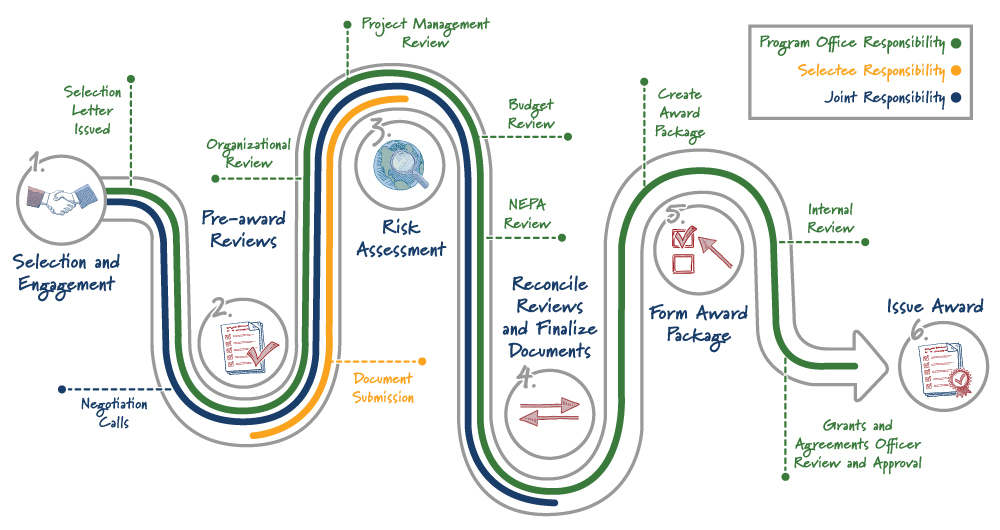Posted on October 31, 2024 by David Solan and Lahra Walker
Since its creation in 1977, the Department of Energy’s (DOE) mission has continued to expand. Born out of a national energy scarcity crisis, DOE now holds the key to cutting-edge innovation with the opportunity to advance first-of-a-kind technology. This exciting new, expanded authority allows DOE to accelerate innovation while streamlining award negotiations.
The ClearPath Proposal to Modernize the U.S. Department of Energy notes that DOE can develop and implement “early-success, early advancement” or “rapid prototyping” initiatives to accelerate promising, high-impact technologies to keep America a global leader. To achieve well-defined milestones on a rapid timeframe, DOE can first seek to identify department-funded research and development (R&D) with proven early success and then quickly provide additional funding. This will promote end-to-end innovation within and across programs, complementing other innovation funding tools across DOE. Such tools include prizes, vouchers to work with the National Laboratories and those from the Advanced Research Project Agency for Energy (ARPA-E). To succeed, an “early-success, early-advancement” program cannot be an ad hoc set of one-off custom contracts; it needs to be an initiative that is replicable.
Under Secretaries can administer rapid prototyping within each of their portfolios and across offices. Such an approach has major advantages without the need for new legislation. Within the confines of the law and compliance, Under Secretaries can expedite decision-making and contracting at their discretion. Doing so enables innovation to advance on merit rather than individual offices doing it themselves. Traditional DOE R&D funding tends to work on two to four-year performance cycles for each award. To ensure less than one year of contracting and research advancement turnarounds, proper leadership at the Under Secretary level and implementation of focused goals will be vital for advancing breakthrough technology. Speed is the name of the game for rapid prototyping to be a success and for the effective application of an accelerated innovation agenda. Increased speed will accelerate market adoption of clean energy technologies to advance key R&D concepts to commercial deployment. Expediting commercially viable technology will help build toward our clean energy future.
Award Negotiation Map

Streamlining the competitive funding process at the outset is an additional key to accelerated innovation. Funding opportunity requirements must be reduced and simplified within Funding Opportunity Announcements (FOAs) and target what is statutorily required. FOAs have significantly increased in size in the last few years and become overly complex. In many cases, requirements that are well-intentioned, but extraneous to the ultimate success of the project are added on.
Limiting the page count of FOA’s would be a first step to address this problem while improving transparency by publishing all administrative and financial requirements to receive an award. To allow DOE to focus on targeting performance and outcomes for the awards, the program policy factors published within every FOA should be limited to five factors to reduce interference. Additionally, rather than prioritizing unrelated social policies such as Community Benefit Plans, Justice40 requirements and Diversity Equity and Inclusion plans, DOE should return its focus to the elements that will determine whether new tech will be successful R&D efforts to advance promising technology. To help reach this goal, it is vital that DOE initiates negotiations immediately upon selection.
Right now, given the increasing inconsistencies throughout DOE offices when managing negotiations, potential awardees don’t know where to start. Widespread standardization is necessary throughout the DOE offices in terms of knowledge-sharing, training, documentation and certification to limit delays and reduce confusion. At times, information requests from DOE for information regarding company practices are intended well but can be difficult for potential awards to navigate. Companies look to protect their intellectual property (IP) and such requests may discourage applicants from moving forward. Cutting-edge research is a high-profile target for foreign adversaries that look to steal U.S. IP, requiring extensive measures to be taken to safeguard it. ClearPath recommends streamlining the requirements for applying for grants, cooperative agreements and loans as well as developing procedures to protect American IP. Streamlined requirements can help prepare companies with what to expect when navigating award negotiations to ensure there will not be requests for information that may compromise an applicant’s IP. By doing so, applicants will be encouraged to continue to move through the process as seamlessly as possible without unexpected roadblocks. This initiative can be further accelerated with metrics to evaluate DOE’s performance during negotiations to ensure the most constructive approach.
There is a middle ground that not only advances innovation, protects the taxpayer and ensures IP protection but also pushes the boundaries of technology and results in a stronger American economy.
Rather than setting desired performance outcomes and enabling applicants to propose how to meet them, DOE tends to dictate project plans. As a result of a long competitive process for the award and a surplus of non-technical requirements, the negotiation process can become quite lengthy. Complex teaming agreements between contractors and subcontractors detailing the scope of work for the companies acting as subcontractors can further slow down the process. Shifting priorities to a principle of technical substance and efficiency instead would achieve a better, more coherent result.
ClearPath wants to see high-impact technologies reach commercialization and deployment at an expedited rate. Streamlining award negotiations while developing and implementing rapid prototyping initiatives will allow this. Guaranteeing access to complementary funding tools across the DOE ecosystem and additional funding can help overcome developmental obstacles projects may face while focusing on technical innovation. To ensure such tools are implemented effectively, efforts should be advanced at the Under Secretary level, with the goal of facilitating contracting and decision-making in the most efficient manner. With the help of DOE’s tools and guidance, American innovators are up for the challenge to create the next generation of energy technology. We believe by refining the partnership between awardees and DOE, the U.S. will remain a global leader for clean energy innovation.
